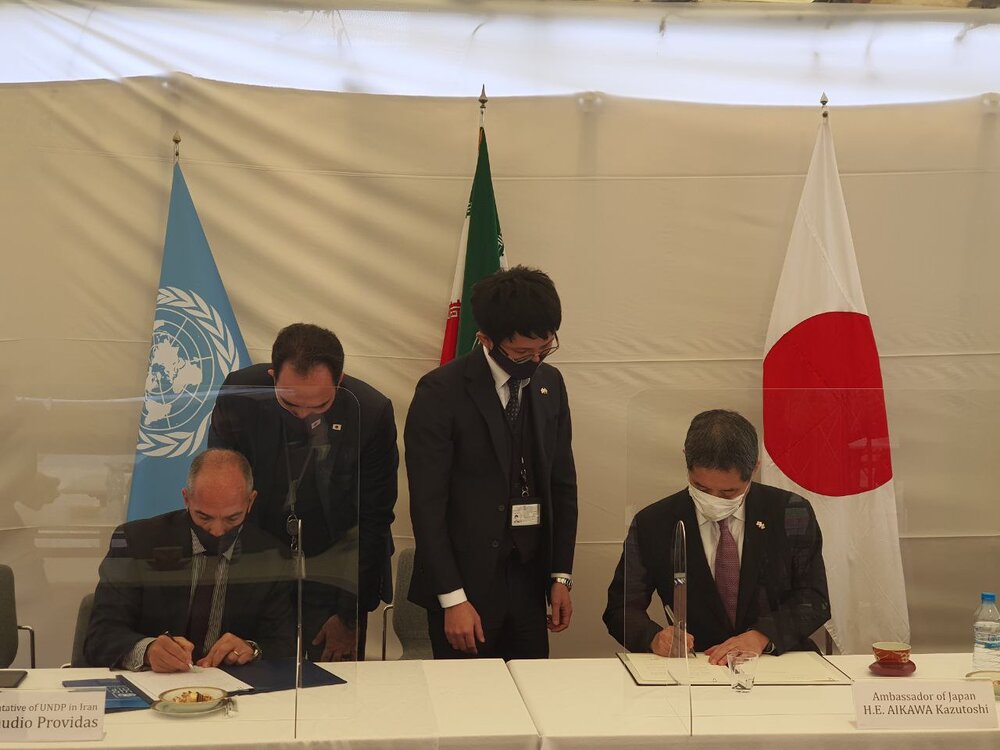Japan, UNDP continue support to restore Lake Urmia

TEHRAN – During a ceremony held in the Japanese Embassy in Tehran on Wednesday, the Government of Japan contributed $3 million to help revive Lake Urmia through the United Nations Development Program (UNDP).
Lake Urmia, located in the northwest of Iran, was once the most extensive permanent hypersaline lake in the world. Unsustainable water management in response to increasing demand together with climatic extremes has given rise to the lake's depletion during the last two decades. The lake’s restoration program was established in 2013 and aims to restore the lake within a 10-year program.
The ceremony was attended by Japanese Ambassador to Tehran Aikawa Kazutoshi, UNDP Representative in Iran Claudio Providas, and Department of Environment Deputy Director Ahmad Reza Lahijanzadeh.
The contribution will be implemented as a component of UNDP’s ongoing Conservation of Iranian Wetlands Project – a joint project between Iran’s Department of Environment and UNDP. This is Japan’s eighth contribution to UNDP Iran.
The new initiative titled “The Project for Promoting Environmental Management and Sustainable Livelihoods in LU and other wetlands” aims to strengthen the sustainable management of natural resources in the fragile ecosystems of the country, while enhancing the economic and livelihood options of communities dependent on such ecosystems – by introducing climate-smart practices, drawing on the successful experience of Japan-UNDP-DOE cooperation in the Lake’s Basin.
By using the capacity built and the lessons learned during seven phases of the project implementation, this new project will be scaled up to additional pilots (and its satellite wetlands) and 2 new replication sites, including Shadegan Wetland (Khuzestan Province), and Bakhtegan Wetland (Fars province).
The project targets the better application of the ecosystem approach in Lake Urmia and its satellite wetlands by making the wetland management committees more active and developing monitoring reports, promoting local participation in sustainable soil and water management and biodiversity conservation by out-scaling the project methods to 140 new villages (80 pilots in Lake Urmia basin and 30 for each of Shadegan and Bakhtegan Wetlands) through the application of an integrated approach while institutionalizing sustainable agriculture practices in the existing 183 villages initiated during 2014-2020.
It also targets to up-scale the project achievements at the national and international level and incorporates the model in high-level documents of the country, as well as enhancing the economic resilience of local communities through a more integrated approach.
This project will also focus on upscaling Lake Urmia restoration achievements and lessons learned to two other internationally important wetlands in Iran (Shadegan and Bakhtegan Wetlands) as part of a national plan.
Conservation efforts
So far, UNDP has implemented several initiatives to stop the degradation trend and restore this important Lake and other wetlands in the country. These efforts have significantly contributed to the stability of Lake Urmia and introducing new approaches based on the improved management of its basin. By the end of the seventh phase, the project was implemented in 183 villages.
Project key achievements and activities during the past seven phases included 35 percent saving in water, and 40 percent decline in chemical pesticide use, significant improvement in inter-sectoral collaboration in the Lake Urmia basin among related organizations, significant improvement in social responsibility among local communities for the restoration.
Some 13,500 farmers introduced to the project, 4,370 of whom were trained; and 242 jobs were generated through the project.
More than 6,000 students and 463 teachers were trained on the role of local communities in the restoration of Lake Urmia, 15 village festivals were held, and 140 exhibitions were held in which farmers got familiar with SA techniques.
However, there are still several priority areas of work, including “wise use of land and water resources and agriculture water-saving”, “innovative sustainable economic initiatives”, “urgent biodiversity conservation” and “awareness-raising” to stabilize the results of the past projects and restore the lake to its optimum ecological situation with the water level of 1274.1.
In addition to almost $7 million in financial support from the Japanese government, so far more than $1 billion has been spent on the project in total.
Lake’s surface area doubled in 6 years
At the beginning of the Lake Urmia Restoration Program in 2013, the Lake’s level was about 1270.32 meters, 1783 square kilometers in surface area, and 1.14 billion cubic meters in volume, which indicates a 50 percent increase in the lake’s surface area in comparison to the current water level.
Lake Urmia’s surface area has reached 2,785 square kilometers, indicating a more than 100 percent rise compared to the lowest volume recorded in the Iranian calendar year 1393 (March 2014-March 2015).
The current level of the lake stands at 1271.24 meters, which increased by more than 1.2 meters compared to the lowest recorded amount, according to Farhad Sarkhosh, head of the Lake Urmia Restoration Program’s office in West Azarbaijan province.
The volume of water also raised by 3.26 billion cubic meters, which has increased more than 5 times compared to the Iranian calendar year 1394 (March 2015-March 2016) and before the Lake Urmia Restoration Program started, he highlighted.
Last year (March 2019- March 2020), over 1.4 billion cubic meters of water released into the lake.
FB/MG
Leave a Comment